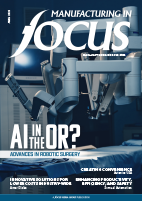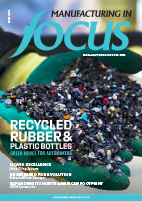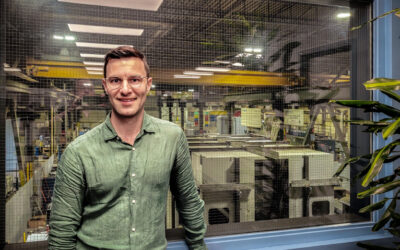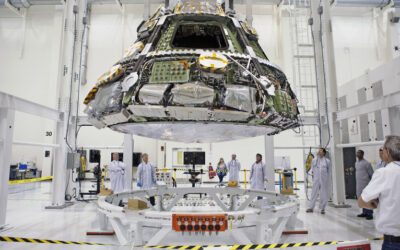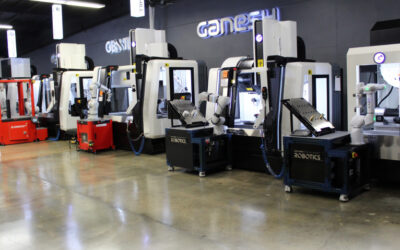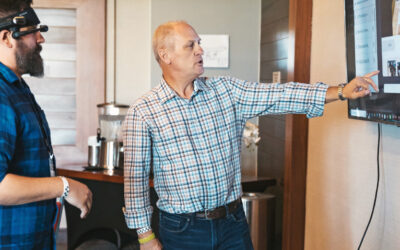LasX Industries designs and manufactures innovative laser processing systems for cutting, etching, scoring, perforating and etching a wide variety of materials used in manufacturing.
~
The company was founded in 1998 and developed a novel laser processing system using a patented control algorithm to control laser power and a scanning system that precisely steers the laser beam over the process material. The basic steering system uses two galvanometer actuators to rotate reflective mirrors that change the location of the laser beam focused on the process material.
Traditionally, laser cutting systems used x-y plotting mechanisms in which a heavy laser focus assembly is held perpendicular to the material and moved along the x- and y-axes. With a scanning system, the beam is steered by the precise movement of mirrors positioned in its path. The founders of LasX wanted to focus on bringing this technology to the manufacturing industry. After twenty years, the company is in the third generation of a proprietary process controller that is used to control the laser power and motion combined with material handling robotics and vision systems.
The benefits of using a laser processing system, particularly the advanced laser process controls offered by LasX, are many. LasX’s technology can be used to process extremely thin materials, such as foil, paper, polyester, plastic and more. It does this much faster than other laser delivery systems and with cleaner edges than conventional die cutting technologies.
“A lot of people think of a laser as a slow-moving aperture that moves across a material,” says David Pung, vice president of business development with LasX. “We built a unique system that allows us to focus on the processing of very thin materials. It’s a tool-less, industrial solution without dies, with applications across a wide market area.”
The range of uses for industrial laser processing is wide. LasX builds equipment for many industries including flexible packaging, print, medical, electronics, aerospace, automotive and more. In the flexible packaging industry, lasers can be used to create easy open features, breathable packaging for vegetables, peel-reseal food packaging and much more. In the print market, LasX equipment is used for everything from labels to fancy graphic stationery with complex cut-away patterns and shapes. Laser processing can be used to create flexible electronics and process thin foil for batteries. Finally, in the medical industry, a technology known as microfluidics is only possible through the use of precision laser cutting and ablation.
The company has a division known as MicroMed Solutions, created to concentrate on the development and high-volume manufacture of microfluidic and biosensor devices for the point-of-care medical industry. Microfluidics is a technology that uses laser ablation to carve fluid channels into a multi-layer laminated film. For example, a person with diabetes who wants to test their blood glucose can prick their finger and touch it to a glucose monitoring strip. Very small channels carved into the strip can then carry blood to specific locations on the strip, where an automated reader can then analyze and provide test results within minutes.
For LasX, delivering a complete manufacturing solution to customers is the final step in a much longer development process. The company works closely with scientists, doctors and other professionals to engineer the perfect solution for a given purpose.
In the flexible packaging market LasX works with a sister company called LaserSharp FlexPak Services, LLC to provide laser processing equipment to many of the world’s largest flexible packaging companies. FlexPak works closely with these clients to help them develop a solution to suit their specific needs. Once the development is complete and the client is ready to take the project into production, LasX will build an engineered laser system to carry the project into production. FlexPak is a leader in food grade packaging designs and, with LasX’s LaserSharp technology, can help customers develop intricate packaging solutions that would not be possible without precision laser processing.
The opportunities presented to manufacturers by using LasX’s technology extend far beyond the advantages of using laser processing over more traditional industrial cutting technologies. LasX is helping to change its customers’ entire manufacturing process. LasX worked on an interesting project for variable data sign printing and finishing for a multibillion-dollar big box store. The machine combined LasX’s laser system and robotics with a digital printer and was designed to create retail signage to go on shelves. The key innovation here was that the equipment could order the prints according to the shelving layout in the store.
Historically, if you needed to print a large number of signs for store shelves of varying sizes, shapes and colors, the process was time-consuming. Sheets would be printed and then fed through a die cutter of a particular size and shape. Once all the signs of that size and shape were cut, the die would be swapped with another, and the process would continue. Once everything was printed and cut, they would be boxed and shipped to the store so that workers could label the shelves. The equipment that LasX developed significantly improves this process.
Using a laser eliminates the need for dies. With a laser, the process no longer determines the order in which these signs need to be cut. This means that a store can give the equipment a list of the signs it needs, in order of how they will be laid out in the store. The machine can then print and cut them in that order, stack them, box them, ship them to the store and significantly reduce the labor time required. In this case, the multi-billion dollar corporation for which LasX designed this equipment said that the labor savings directly affected its bottom line. This is an incredible achievement, as it demonstrates the company’s ability to develop technology that will significantly affect the way industrial manufacturing is done on a vast scale.
“It’s a great example of digital directly impacting the way we manufacture,” says Pung. “We have to look beyond the laser processing itself and ask how we can do it differently. You are not limited to a die-cutter that runs only one shape and stops to change over the die. Our LaserSharp® solution allows our customer to think about things completely differently.” Using these technologies, LasX is giving companies the ability to make processes more efficient and improve their return on investment.
LasX is committed to changing the way manufacturers think about their processes. Another of LasX customer was considering robotics to speed up production. This company creates paper products that require die cutting, and six people collated all the paper product coming out at the end of the production line. LasX presented a robotic collation solution to improve production throughput with full automation. The value of a laser in a case like this is not its ability to run quickly, but its ability to organize the process and eliminate the need for collation completely.
“The old mentality was to split everything up to run them in like-die-cuts, then aggregate it all back together,” says Pung. “With lasers you can keep those orders together, as tight as possible.”
That is the impact of LasX’s innovation. It is more than a technology; it is an on-demand manufacturing solution powered by laser processing and automation that maximizes productivity and flexibility without added labor. LasX is a manufacturing solutions company at its core and is driven by the engineering mindset toward manufacturing innovative, automated laser solutions for industry.


